CIMMYT and IITA training on management of seed production and maize field trials
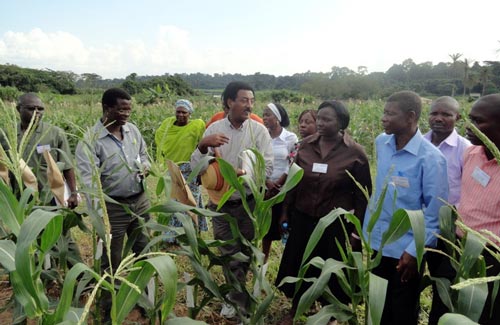 During 27 August – 1 September 2012, the Drought Tolerant Maize in Africa (DTMA) project held a training course on management of field trials and nurseries and seed production of open pollinated and hybrid maize varieties. The course took place at the International Institute of Tropical Agriculture (IITA) in Ibadan, Nigeria, and was attended by 30 participants from Ghana and Nigeria, including CIMMYT scientists Peter Setimela and John MacRobert. The resource persons were drawn from Nigerian universities, the National Agriculture Research System, IITA, and CIMMYT.
During 27 August – 1 September 2012, the Drought Tolerant Maize in Africa (DTMA) project held a training course on management of field trials and nurseries and seed production of open pollinated and hybrid maize varieties. The course took place at the International Institute of Tropical Agriculture (IITA) in Ibadan, Nigeria, and was attended by 30 participants from Ghana and Nigeria, including CIMMYT scientists Peter Setimela and John MacRobert. The resource persons were drawn from Nigerian universities, the National Agriculture Research System, IITA, and CIMMYT.
The training session was opened by Nteranya Sanginga, IITA director general, who commended the collaboration between IITA and CIMMYT in implementing DTMA and working towards its vision of producing more than 70,000 tons of drought tolerant maize seed. Sanginga also spoke of the importance of training to empower maize technicians from the national maize programs and seed companies to manage field trials and produce quality seed needed by smallholder farmers in Ghana and Nigeria.
The training course emphasized the importance of good trial management, advanced experimental designs, management of maize nurseries and variety trials, and key aspects of seed production. Training included practical field sessions during which participants applied appropriate experimental designs for various fields and learnt how to lay out a field trial. They also tried various pollinating techniques used in maize breeding and variety maintenance.
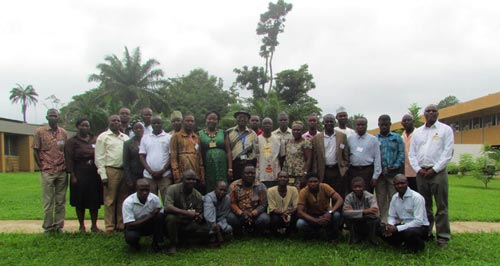
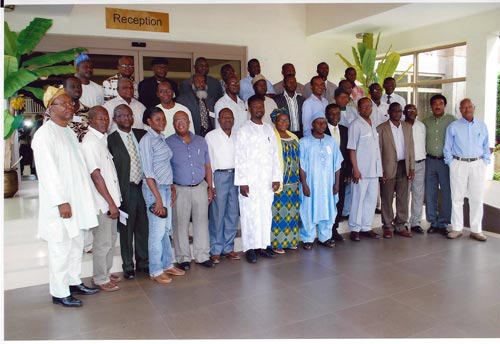 The Regional Planning Meeting for phase III of the Drought Tolerant Maize for Africa (DTMA) project was held in Kumasi, Ghana, during the week of 16-19 April 2012. The objectives of this meeting were to (i) review and document progress on DTMA project activities conducted in West Africa in 2011, (ii) present, critically review, and approve project proposals submitted for funding by partner countries Benin Republic, Ghana, Mali, and Nigeria under phase III, and develop work plans for the 2012 cropping season. The regional meetings have proved instrumental in planning and monitoring of DTMA project activities and building the requisite partnerships for successful implementation of the project.
The Regional Planning Meeting for phase III of the Drought Tolerant Maize for Africa (DTMA) project was held in Kumasi, Ghana, during the week of 16-19 April 2012. The objectives of this meeting were to (i) review and document progress on DTMA project activities conducted in West Africa in 2011, (ii) present, critically review, and approve project proposals submitted for funding by partner countries Benin Republic, Ghana, Mali, and Nigeria under phase III, and develop work plans for the 2012 cropping season. The regional meetings have proved instrumental in planning and monitoring of DTMA project activities and building the requisite partnerships for successful implementation of the project.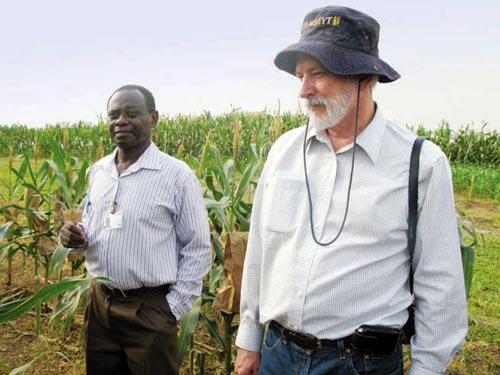 On 15 February 2012, CIMMYT director general Tom Lumpkin met with his peer, Nteranya Sanginga, at the headquarters of the International Institute of Tropical Agriculture (IITA) in Ibadan, Nigeria. Accompanied by CIMMYT-Regional Liaison Officer, Wilfred Mwangi, Lumpkin also interacted with IITA maize breeders Baffour Badu-Apraku, Abebe Menkir, and Sam Ajala, as well as IITA socioeconomist Tahirou Abdoulaye.
On 15 February 2012, CIMMYT director general Tom Lumpkin met with his peer, Nteranya Sanginga, at the headquarters of the International Institute of Tropical Agriculture (IITA) in Ibadan, Nigeria. Accompanied by CIMMYT-Regional Liaison Officer, Wilfred Mwangi, Lumpkin also interacted with IITA maize breeders Baffour Badu-Apraku, Abebe Menkir, and Sam Ajala, as well as IITA socioeconomist Tahirou Abdoulaye.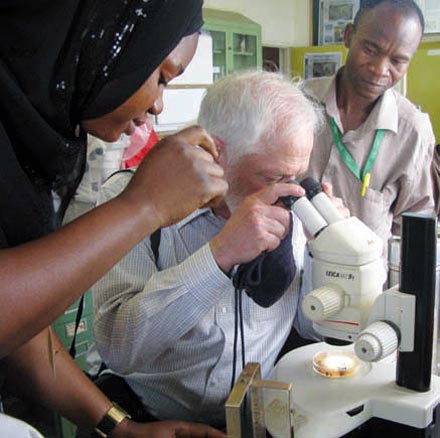 Lumpkin and Mwangi visited IITA maize trials, including those of maize bred for resistance to the parasitic flowering plant, Striga spp., through crosses with teosinte. Attaching to sprouting maize seedlings, Striga saps nutrients and imparts a toxin that slows growth. It causes damage to Africa’s maize estimated in the billions of dollars and affects as much as 40 million hectares of food crops across the region. Teosinte belongs to the same genus as maize and is considered the crop’s predecessor.
Lumpkin and Mwangi visited IITA maize trials, including those of maize bred for resistance to the parasitic flowering plant, Striga spp., through crosses with teosinte. Attaching to sprouting maize seedlings, Striga saps nutrients and imparts a toxin that slows growth. It causes damage to Africa’s maize estimated in the billions of dollars and affects as much as 40 million hectares of food crops across the region. Teosinte belongs to the same genus as maize and is considered the crop’s predecessor.